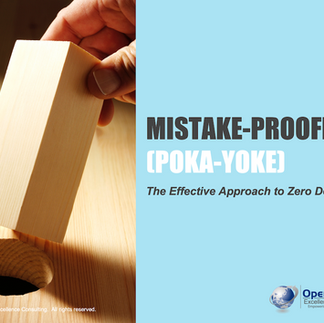Allan Ung

“Where there is no standard,
there can be no Kaizen.”
Taiichi Ohno
Introduction
In the world of manufacturing, standardization is a crucial factor that determines the success or failure of an organization. Standard work, in particular, is an important tool that enables manufacturers to create a consistent, repeatable process that meets the customer's needs while minimizing waste. In this blog post, we will explore the concept of standard work, its benefits, prerequisites, characteristics, the elements, and how it can be implemented and sustained.
Standardization vs Standards vs Standard Work

Standardization Framework
Standardization is the practice of setting, communicating, following, and improving standards and standard work. Standards, in this context, are rules or examples that provide clear explanations of how work should be done. Standard work, on the other hand, is a set of work procedures that establish the best and most reliable methods and sequences for each process and each worker.
What is Standard Work?
Standard work is an agreed-upon set of work procedures that establish the best and most reliable methods and sequences for each process and each worker. It is written for operators or the frontline staff and is kept visible in the work area, near an operator’s machine or workstation. Standard work is documented using lots of visuals and pictures instead of narrative text and serves as a reference for use in the real workplace, outlining the actions to be performed, any needed tools, materials, work flow, and work pace expected at that position.
What Standard Work Is Not
Standard work is not necessarily based on ISO 9001, cGMP, or other regulatory standards, although it may incorporate elements of these standards. It is also not a static or once-and-for-all documentation of how to do a job. While it provides a clear set of guidelines for performing tasks, it is not restrictive like a soldier's "rules of engagement". Standard work does not aim to destroy innovation and creativity.

Standard Work Creates a Baseline for Innovation
On the contrary, it allows operators and frontline staff to identify inefficiencies and make improvements to the process. Finally, it is important to note that standard work is not created solely by leaders for operators or frontline staff. Instead, it is a collaborative effort that involves input from all levels of the organization to ensure that the best practices are documented and continuously improved upon.
Benefits of Standard Work
There are several benefits of standard work, including:
1. Clarifies the process: Standard work documents the best way to do a job, ensuring everyone is on the same page.
2. Ensures operating consistency: Standard work ensures that work is done the same way each time, which improves quality, productivity, and safety.
3. Expedites employee training: Standard work provides a structured approach to employee training, making it quicker and more efficient.
4. Provides the baseline for improvement: Standard work serves as the foundation for continuous improvement, allowing organizations to measure progress and make changes as needed.
Prerequisites for Standard Work
There are several prerequisites for standard work, including 5S and visual controls, quick changeover, mistake-proofing, total productive maintenance, human automation, cellular manufacturing, pull production with kanban, and line balancing. These practices help ensure that the work environment is optimized for standard work and that the necessary tools and resources are available.
Components and Implementation
Standard work consists of several components, including standards and standardization, takt time, standard work sequence, and standard work-in-process inventory. To implement standard work, organizations should follow four steps: observe the current process, standardize the process, implement the standard, and continuously improve the standard. Sustaining standard work requires ongoing monitoring and evaluation to ensure that the standard remains relevant and effective.
Characteristics of Standard Work

Characteristics of Standard Work
(Source: Adapted from Curtis)
To be effective, standard work must be current, complete, clear, correct, concise, and communicated. It should be visible in the work area, near the operator's machine or work station. Additionally, it should be reviewed and updated regularly to ensure that it remains relevant and accurate.
Ideal Conditions for Standard Work
The ideal conditions for standard work include several factors.
From the work point of view, the work should be centered around human motion, which means that the work should be designed in a way that is easy for the worker to perform. Work should be done the same way each time with small variations in work content, to ensure consistent results.
From the equipment point of view, the machines should have minimal trouble and should be well-maintained to avoid any delays in production. There should also be minimal fluctuation in production volume to avoid any bottlenecks in the process.
From the quality point of view, there should be minimal trouble in process quality, meaning that the processes should be designed in a way that minimizes defects, rework, or delays. The same goes for parts and materials – there should be minimal trouble in their quality to avoid any issues with the final product. Overall, the ideal conditions for standard work aim to maximize efficiency, minimize waste, and ensure consistent quality.
Three Elements of Standard Work

Three Elements of Standard Work
There are three elements of standard work: takt time, standard work sequence, and standard work-in-process inventory. Takt time matches the time to produce a part or finished product with the rate of sales, which is the basis for determining workforce size and work allocation. The standard work sequence is the order in which a worker performs tasks for various processes. Finally, the standard work-in-process inventory is the minimum number of parts, including units in machines, required to keep a cell or process moving.
Four Steps to Standard Work

Four Steps to Standard Work
The four steps to standard work involve the following:
Step 1: Create a Process Capacity Table
This step involves determining the rate at which the process needs to produce to meet customer demand. The process capacity table takes into account the cycle time, the total available production time, and the expected demand to calculate the required production rate.
Step 2: Create a Standard Operations Combination Chart
This step involves identifying and documenting the sequence of operations required to complete the process. The chart outlines the different combinations of manual and machine operations that must be performed to produce the required output within the cycle time.
Step 3: Create a Work Methods Chart
This step involves breaking down each operation into individual tasks and documenting the best way to perform each task. The work methods chart includes information on the tools, equipment, materials, and work sequence needed to perform each task efficiently.
Step 4: Create a Standard Work Chart
This step involves combining all the information from the previous steps to create a visual representation of the standard work process. The standard work chart includes information on the takt time, the standard operations sequence, the standard work-in-process inventory, and the standard work procedures for each operation. It is a reference for the operators to ensure that they are performing their tasks consistently and efficiently.
Guidelines for Maintaining Standard Work
Maintaining standard work requires a commitment from everyone in the organization. Workshop leaders and trainers must be committed to the operations they teach, and everyone must understand the importance of standard work. Posting visual displays and descriptions of standard operations can help operators compare their own work to the standards. Bringing in a third party or subject matter expert can help clear up any misunderstandings. Additionally, workshop leaders must be held responsible for maintaining standard work and continually improving existing standards.
Approaches to Improving Standard Work
There are many approaches to improving standard work, including understanding true versus apparent efficiency, eliminating the eight types of waste, applying the three MU's (muda, mura and muri), conducting Kaizen activities, reducing lot size, improving safety, and implementing 5S good housekeeping and workplace organization.
Opportunities for Improving Standard Work
There are several potential areas for improving standard work. One opportunity is to focus on the flow of materials, ensuring that they move smoothly and efficiently through the process. Another is to shift from specialization to multi-skilled lines and operators, allowing for greater flexibility in the workforce. Improvements in motion can also be made by establishing rules for operations, such as eliminating walking and shifting from one-handed to two-handed tasks. Equipment can also be optimized, with a focus on separating people and machines and ensuring that parts are placed in the most accessible locations. Finally, preventing defects is also an important area for improvement, with a focus on identifying and eliminating potential sources of errors in the process. By addressing these areas, organizations can improve their standard work and ultimately drive better performance and productivity.
Conclusion
In conclusion, standard work is a crucial element in ensuring consistent and efficient performance in the workplace. It establishes the best and most reliable methods and sequences for each process and each worker, clarifying the process and providing a baseline for improvement. Standard work must be current, complete, clear, correct, concise, and communicated to be effective. It consists of three elements: takt time, standard work sequence, and standard work-in-process inventory. To maintain standard work, it is essential to establish standard operations throughout the factory, make sure everyone understands the importance, post visual displays and graphic and text descriptions of standard operations, bring in a third party or subject matter expert, and reject the status quo. Opportunities for improving standard work include improving the flow of materials, establishing rules for operations, separating people and machines, preventing defects, eliminating walking, shifting from one-handed to two-handed tasks, and optimizing the placement of parts. By continuously pursuing improvements in standard work, organizations can enhance their operational efficiency, reduce waste, and improve their bottom line.

Article by Allan Ung, Principal Consultant at Operational Excellence Consulting, a distinguished management consultancy based in Singapore. Our firm specializes in maximizing customer value and minimizing waste through the strategic adoption of Design Thinking and Lean management practices. For further details, please visit www.oeconsulting.com.sg













Comments